Super Pepe (SUPEPE) is a 2025 meme coin with a charitable twist. In this post, you will discover some realistic price scenarios, a...
Based on our testing, Best Wallet is the top P2P platform for most users in 2025. You get access to over 1,000 cryptos, 100+ payment methods, and you don’t need to provide any ID documents.
For traders with different needs, MEXC supports 4,000+ trading pairs after your P2P purchase completes, and OKX’s Block Trade feature helps large buyers get better rates on orders over $10,000.
You can buy cryptocurrencies directly from local sellers when using peer-to-peer (P2P) exchanges. P2P platforms, which often support hundreds of payment methods and currencies, sometimes allow users to avoid KYC, too, making them a great option if you don’t want to provide a government-issued ID.
We examine the best P2P crypto exchanges in 2025, ranking the top platforms for trading fees, purchase methods, delivery times, and available assets. Learn how P2P trading works and how to stay safe when completing orders.
Key Takeaways for P2P Crypto Exchanges
- Best Wallet leads for versatility – Supports 1,000+ cryptocurrencies with 100+ payment methods and requires no KYC, making it ideal for privacy-focused users who want broad crypto access.
- MEXC excels for portfolio building – While the P2P platform only supports 4 main coins, users gain access to 4,000+ trading pairs on the main exchange after completing their P2P purchase.
- OKX dominates large trades – The Block Trade feature caters to investors buying $10,000+ worth of crypto, offering better rates than traditional OTC brokers in a market projected to reach $16 trillion by 2034.
- Security through escrow is standard – All major P2P platforms use escrow systems where sellers must deposit crypto before buyers send payment, significantly reducing fraud risk.
- KYC requirements vary widely – Best Wallet, MEXC, and BingX allow anonymous trading, while Binance and OKX require full identity verification for all users.
- P2P beats traditional exchanges for payment flexibility – Most platforms support 100-900 payment methods including local bank transfers, e-wallets, and mobile payments across 30-100+ currencies.
- Liquidity remains limited compared to spot markets – P2P volumes represent a fraction of traditional exchange volumes, with individual sellers typically handling thousands rather than millions in daily trades.
The Top 7 P2P Crypto Exchanges in 2025
Our research shows that these are the best P2P Bitcoin exchange platforms:
- Best Wallet – The Overall Best Place to Buy Crypto With Local Payment Methods
- MEXC – Access Over 4,000 Trading Pairs After Completing the P2P Payment
- OKX – Buy Large Amounts via the Block Trade Feature for Top Market Rates
- Binance – Purchase USDT Below the Market Price to Secure Arbitrage Opportunities
- Bybit – No P2P Trading Fees and Reduced Seller Rates With Super Vouchers
- BingX – Best Peer-to-Peer Platform to Access Copy Trading, Bots, and Derivatives
- Margex – Trade Crypto Futures With 100x Leverage Starting From Just $5
7 Best Peer-to-Peer Crypto Exchanges Reviewed
Below you’ll find extensive reviews of the top peer-to-peer platforms. Read on to choose the best P2P cryptocurrency exchange.
1. Best Wallet – Top Anonymous Crypto App with Instant Fiat Purchases and Low Fees
Best Wallet is a popular crypto app for iOS and Android that offers an anonymous trading experience. The app serves as both a non-custodial wallet and an exchange. Users can buy over 1,000 cryptocurrencies instantly using bank transfers, debit and credit cards, and e-wallets such as Google Pay and Apple Pay.
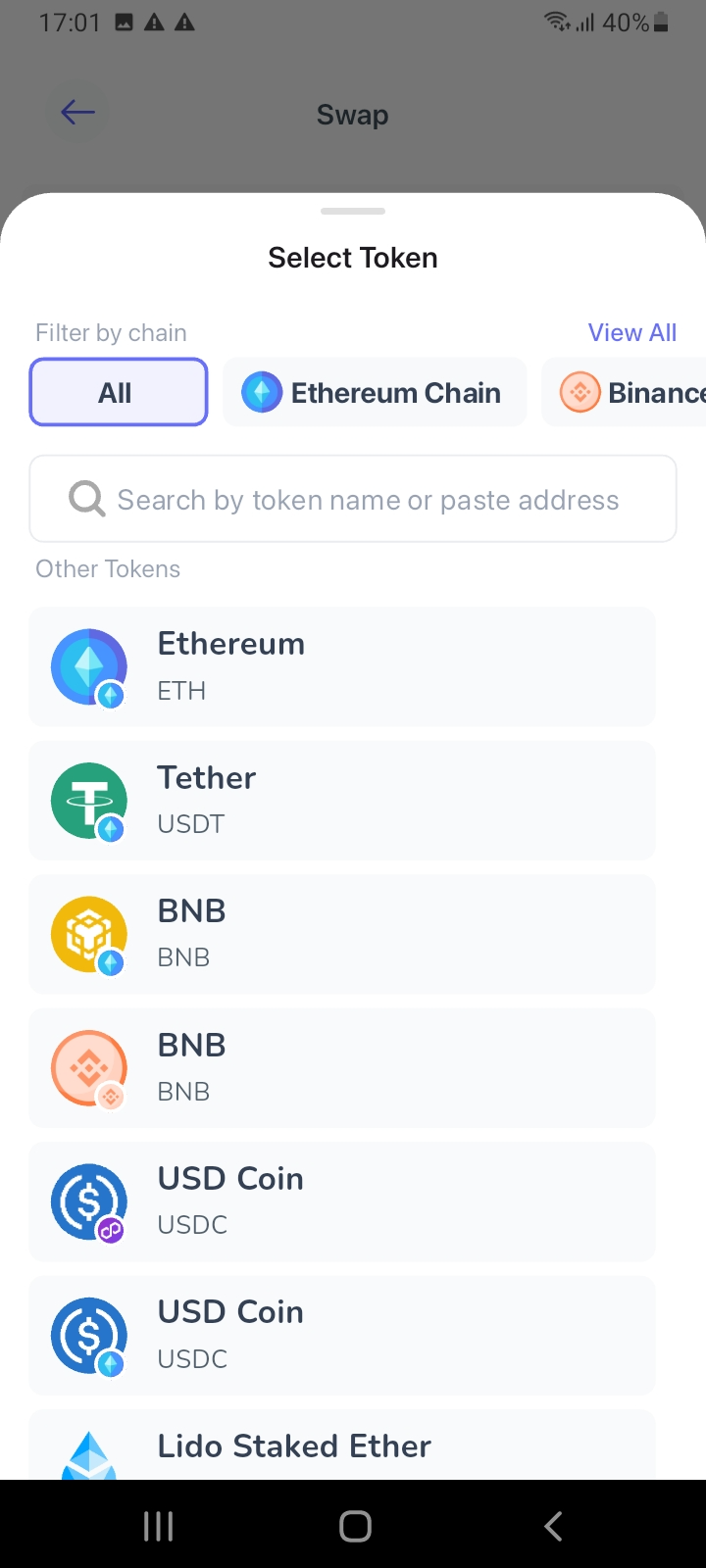
Users get the best market fees, as Best Wallet sources exchange rates from hundreds of liquidity providers. Once the P2P payment is processed, cryptocurrencies are safely stored in the wallet balance – security controls include biometrics and two-factor authentication via SMS. Other Best Wallet features include a token Launchpad and instant token swaps.
| Available P2P Coins | 1,000+ |
| Payment Types | 100+ |
| Local Currencies | 30+ |
| Mobile App | Yes – iOS and Android |
| KYC? | No |
| Core Features | The most extensive range of supported P2P coins. Buy crypto anonymously with 30+ currencies. The app stores purchased coins in a self-custody wallet. |
Pros
- A top P2P crypto exchange with no KYC
- Buy over 1,000+ coins with local payment methods
- Cryptocurrencies transfer instantly to the built-in wallet
- Users get the best market rates via liquidity partners
- Swap tokens instantly without leaving the app
Cons
- Less established than most P2P crypto exchanges
- Only available as a mobile app
2. MEXC – The Best Option for Portfolio Diversification with 4,000+ Supported Crypto Pairs
MEXC’s P2P crypto marketplace offers a no-KYC experience – users open an account with an email or mobile number only.
While the P2P platform supports USDT, USDC, Bitcoin, and Ethereum, the main MEXC exchange has over 4,000 trading pairs. Markets include traditional spot trading and crypto derivatives with leverage of up to 500x.
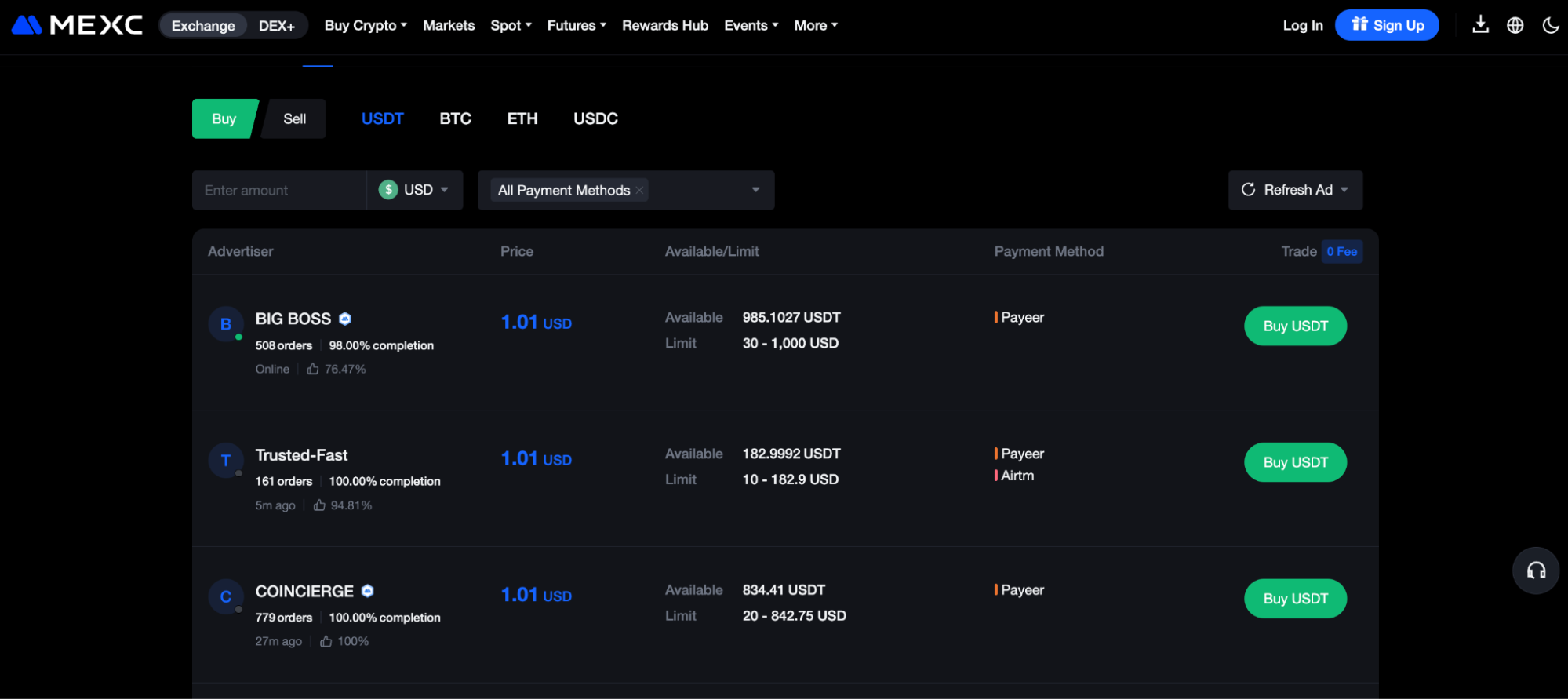
No additional fees are charged when buying cryptocurrencies from P2P sellers, and exchange rates are typically just above the global spot price. Limits are lower than on other platforms, so MEXC is a better fit for those who want to buy small amounts.
| Available P2P Coins | USDT, USDC, Bitcoin, and Ethereum |
| Payment Types | 100+ |
| Local Currencies | 25+ |
| Mobile App | Yes – iOS and Android |
| KYC? | No (up to 20,000 USDT daily) |
| Core Features | P2P buyers access over 4,000 trading markets. Avoid KYC when withdrawing under 20,000 USDT daily. The main exchange offers institutional-grade liquidity. |
Pros
- Purchase digital assets with over 100 payment types
- P2P rates often sit just above spot prices
- The platform doesn’t add additional fees to quoted exchange rates
- Access 1,000+ markets with the same P2P account
- Get 500x leverage when trading futures
Cons
- The P2P exchange doesn’t support meme coins
- Some trading products aren’t suitable for beginners
3. OKX – A Great Option for P2P Traders Who Want to Purchase Large Amounts ($10,000+)
OKX is the go-to exchange for P2P traders with significant purchase requirements. Its Block Trade feature targets large-scale investors who need to buy over $10,000 worth of digital assets – in a market that’s projected to hit $16 trillion by 2034. The feature ensures that traders minimize the price impact and get the most competitive exchange rates without relying on over-the-counter (OTC) brokers.
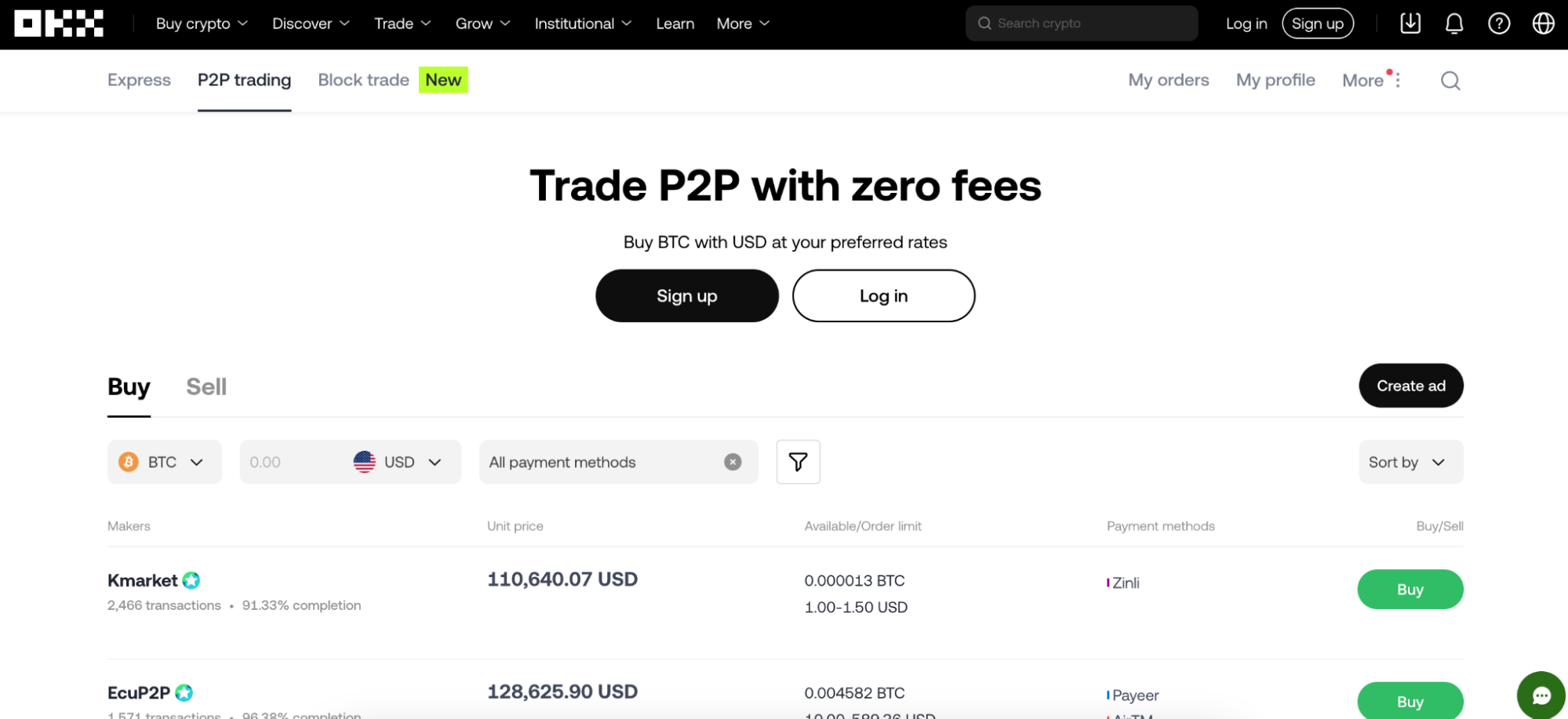
The peer-to-peer crypto exchange supports USDT, USDC, Bitcoin, and Ethereum. Traders can choose from over 900 payment methods, including local and international transfers, e-wallets, and popular banking apps such as Revolut and Cash App. Once the assets are delivered to OKX, users can access hundreds of other markets, including spot trading, delivery futures, and options.
| Available P2P Coins | USDT, USDC, Bitcoin, and Ethereum |
| Payment Types | 900+ |
| Local Currencies | 100+ |
| Mobile App | Yes – iOS and Android |
| KYC? | Yes |
| Core Features | Buy over $10,000 worth of cryptocurrencies at top market prices. Choose from over 900 payment types. Access derivative products after finalizing the P2P trade. |
Pros
- One of the best P2P Bitcoin exchanges for large-scale investors
- Settle trades in over 100 fiat currencies
- Competitive exchange rates without additional fees
- Backed by a tier-one exchange with deep liquidity
Cons
- Identity verification is compulsory for all accounts
- Geolocation restrictions in some countries
- Better options exist for those investing small amounts
4. Binance – Access Thousands of Dollars Worth of USDT Below the Spot Price
Binance users can purchase USDT on its P2P platform below the market price – multiple trading partners offer thousands of dollars worth of liquidity at sub-$1 per token. This is happening on a platform that processes over 7.5 million P2P transactions annually, with the exchange dominating 39.8% of global spot trading volume in 2025. This price dynamic lets users secure arbitrage opportunities, as P2P rates are locked in while buyers complete payment.
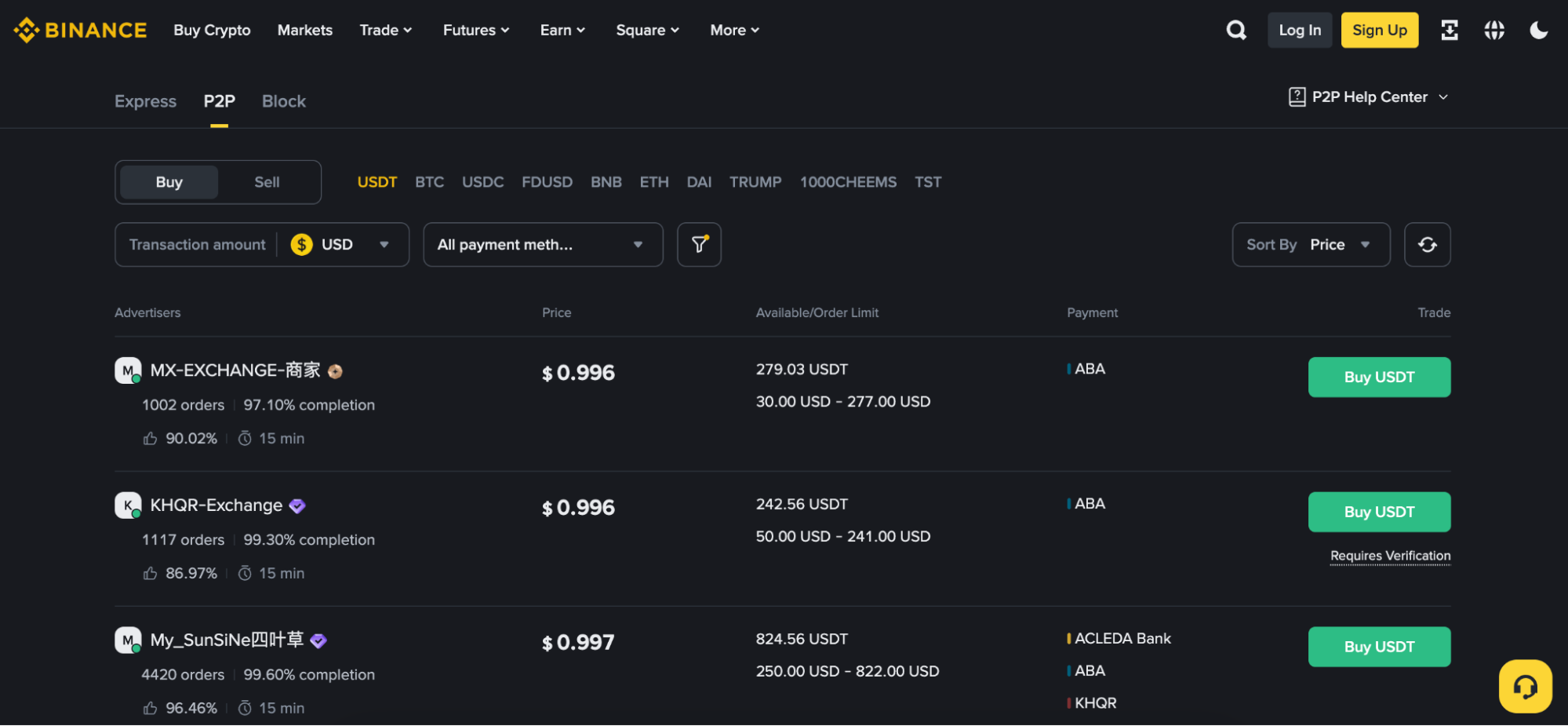
P2P traders have over 800 payment methods to choose from across over 100 currencies, including popular e-wallets like Skrill and Neteller. Binance ensures safe trading via a P2P escrow system, and both buyers and sellers must go through a KYC process before they get started.
| Available P2P Coins | USDT, USDC, Bitcoin, Ethereum, Dai, FDUSD, BNB, OFFICIAL TRUMP, 1000CHEEMS, and Test |
| Payment Types | 800+ |
| Local Currencies | 100+ |
| Mobile App | Yes – iOS and Android |
| KYC? | Yes |
| Core Features | Many P2P sellers offer USDT below the spot price. The P2P dashboard supports 10 cryptocurrencies. The average trade time is just 15 minutes. |
Pros
- Invest in cryptocurrencies at sub-spot rate prices
- Supports 800+ payment methods, including dozens of e-wallets
- The best P2P crypto exchange platform for liquidity and trading volume
- Fast P2P settlement times in most cases
Cons
- It is no longer a P2P Bitcoin exchange with no KYC
- Some sellers require additional verification documents (e.g., proof of residency)
- The exchange isn’t available in all countries
5. Bybit – Cost-Effective P2P Trading with No Markups and Free Voucher Discounts
Bybit is the world’s second-largest crypto exchange after Binance. It commands daily trading volumes of several billion dollars, and the platform recently surpassed 71 million users. The peer-to-peer suite supports USDT, USDC, Bitcoin, and Ethereum, and buyers have over 600 deposit options, including mobile payments, local transfers, and PayPal. The platform also offers more favorable exchange rates when claiming a super voucher. The drawback is that vouchers require users to complete KYC verification.
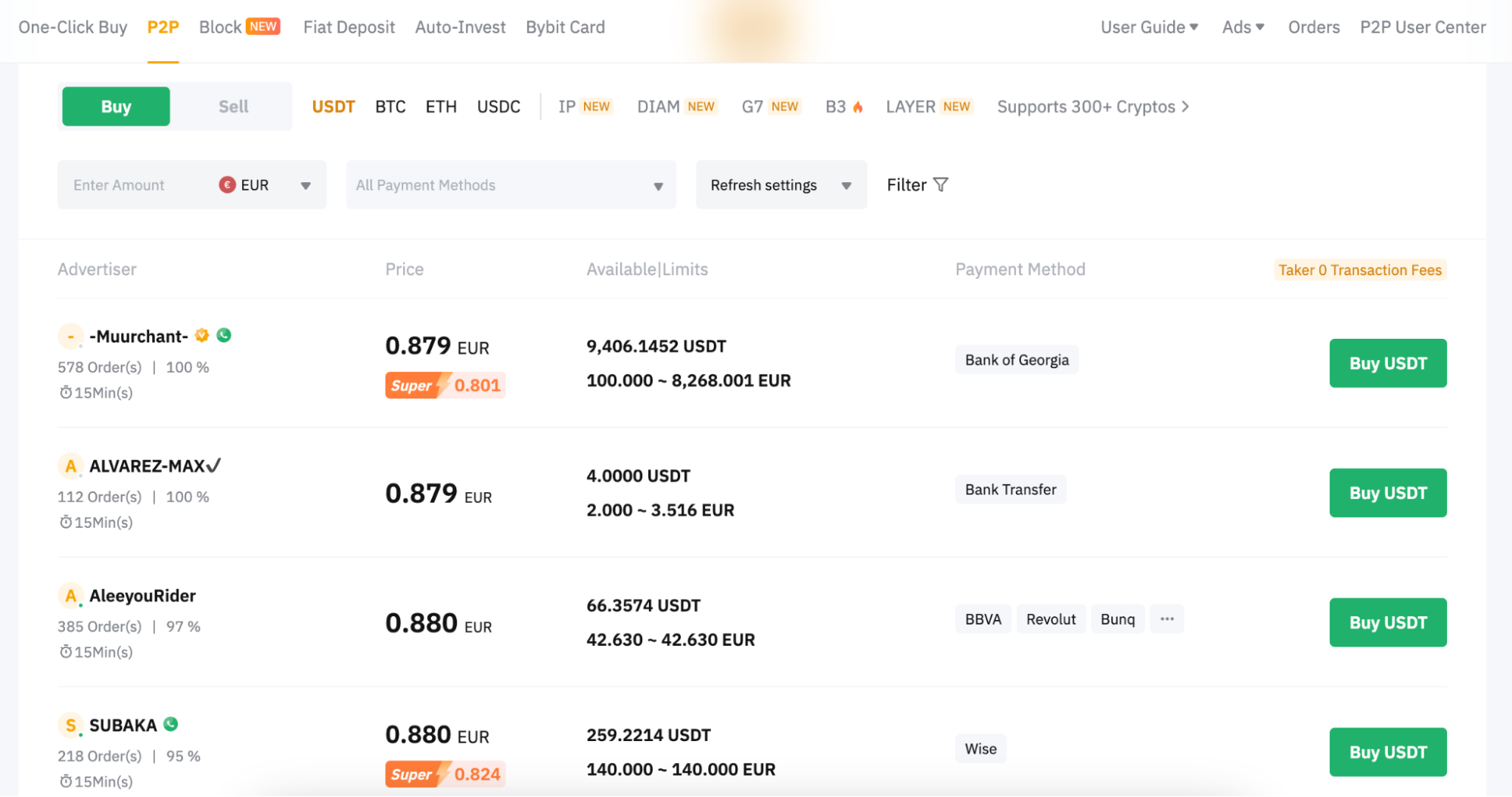
Users who prefer anonymity can withdraw up to 20,000 USDT daily without providing personal information or ID documents.
| Available P2P Coins | USDT, USDC, Bitcoin, and Ethereum |
| Payment Types | 600+ |
| Local Currencies | 60+ |
| Mobile App | Yes – iOS and Android |
| KYC? | No (up to 20,000 USDT daily) |
| Core Features | Offers more competitive exchange rates when users complete KYC. Rates lock in while the buyer completes payment. Supports over 600 deposit methods. |
Pros
- Top peer-to-peer cryptocurrency exchange for low fees
- Huge liquidity when buying stablecoins
- The main platform offers perpetual futures with 200x leverage
Cons
- Super vouchers aren’t valid unless ID documents are provided
- Operates without regulatory supervision
- The Bybit exchange was hacked in 2025 (user funds were not impacted)
6. BingX – Purchase USDT in Under 10 Minutes to Access a Huge Range of Trading Features
BingX’s P2P crypto exchange supports just one asset — USDT, yet it remains one of the best options to access the broader markets. BingX supports over 1,000 cryptocurrencies, including spot trading and perpetual futures with leverage of up to 125x. Automated tools include grid bots and copy trading.
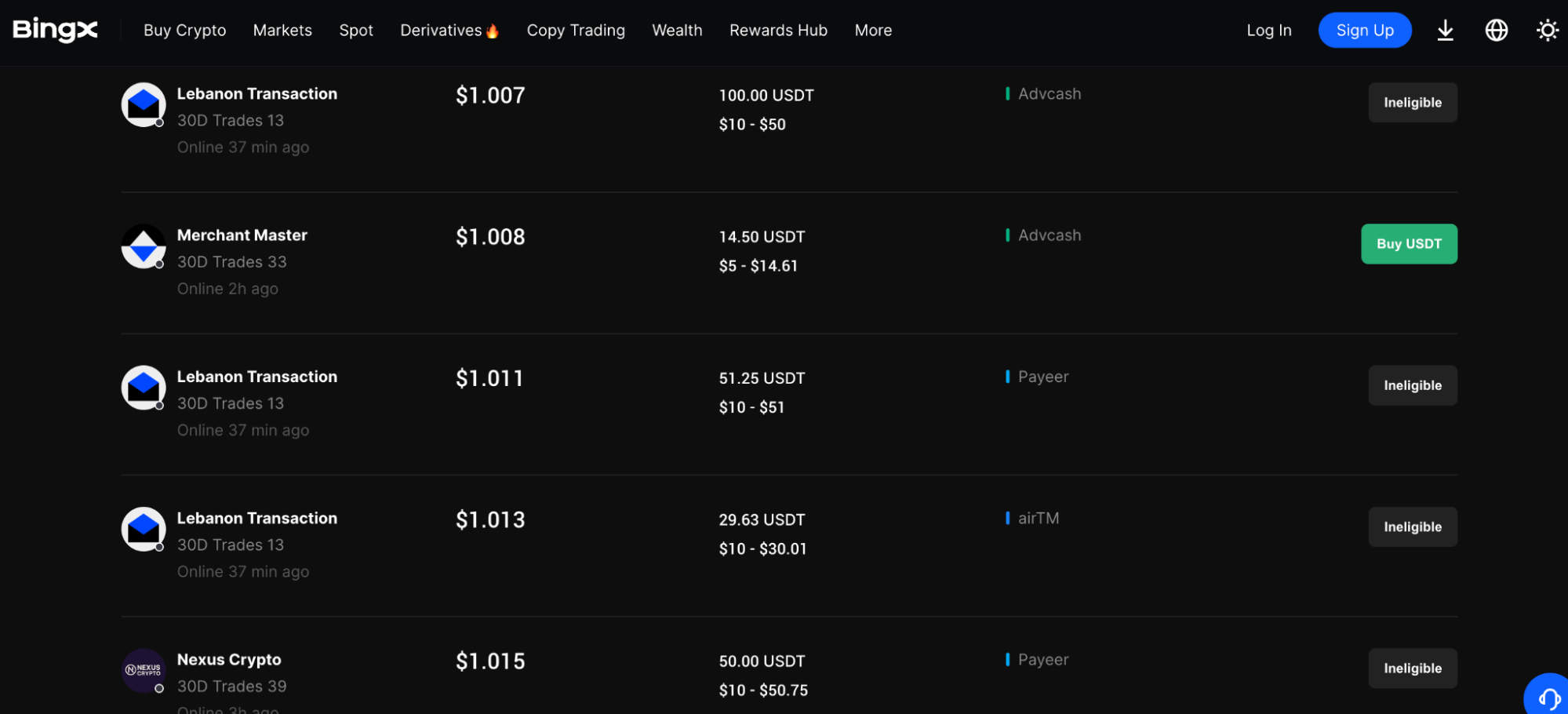
The P2P exchange supports over 300 payment types and over 65 fiat currencies. Local methods include mobile transfers, LINE Pay, and Wing Money.
Most peer-to-peer sellers have a minimum purchase requirement of just $10, and upper limits often exceed several thousand dollars.
| Available P2P Coins | USDT |
| Payment Types | 300+ |
| Local Currencies | 65+ |
| Mobile App | Yes – iOS and Android |
| KYC? | No |
| Core Features | Most P2P trades complete in under 10 minutes. Small minimums of about $10. The main exchange offers automated tools, spot markets, and derivatives. |
Pros
- Supports over 300 P2P payment methods
- Competitive market rates when you buy small amounts
- Access futures, bots, and copy trading on the primary platform
Cons
- Some sellers require in-person cash transfers
- The P2P exchange only supports USDT
- Tier-two trading volumes
7. Margex – Trade Crypto Futures with 100x Leverage Starting From Just $5
Margex launched as a derivatives-focused exchange that now serves traders across 170+ countries with daily volumes exceeding $4 billion. The platform specializes in perpetual futures trading with leverage up to 100x on major pairs.
The platform has accessible futures trading – you can open positions with just $5 and trade 55 cryptocurrency pairs including Bitcoin, Ethereum, and popular meme coins.
Margex requires only 1% margin on large-cap markets, so a $100 deposit controls $10,000 in trading capital.

Other features include copy trading tools, staking rewards up to 13% APY, and educational resources for futures trading strategies.
| Available P2P Coins | Bitcoin, USDT, USDC, Ethereum, and 50+ altcoins |
| Payment Types | 152 |
| Local Currencies | 40+ |
| Mobile App | Yes – iOS and Android |
| KYC? | No (for trading), Yes (for fiat deposits) |
| Core Features | Futures trading with 100x leverage and 1% margin requirements. Copy trading feature connects beginners with profitable traders. Minimum deposits start at $5. |
Pros
- Start futures trading with just $5 minimum deposit
- Access 100x leverage on Bitcoin and Ethereum futures
- Copy successful traders automatically through the platform
- No KYC required for crypto-to-crypto trading
Cons
- Focuses primarily on derivatives rather than spot P2P trading
- High leverage products carry significant loss potential
- Not available to US or Canadian residents
What Are & How Do P2P Bitcoin Exchanges Work?
P2P crypto exchanges support peer-to-peer transactions – users purchase digital assets directly from sellers rather than on centralized exchange order books. The P2P concept enables users to settle trades in domestic currencies and use local payment methods, such as local transfers and e-wallets.
The escrow safeguard sits at the heart of P2P trading. Escrow systems ensure sellers deposit the required cryptocurrencies into the exchange’s wallet, which are locked while the buyer makes payment. The seller confirms they’ve received the funds, and the P2P platform transfers the crypto assets to the user’s wallet.
In terms of trading fees, the best P2P crypto exchanges let sellers choose their preferred rates. Merchants that require a quick sale often set rates below the global spot price, providing buyers with a discount.
P2P Crypto Exchanges vs Standard Exchanges
While most P2P platforms are backed by traditional exchanges, the crypto trading process differs.
Here’s how peer-to-peer and standard exchanges compare.
Crypto Prices
P2P sellers choose the exchange rate that they wish to offer – this can be more or less competitive than the actual market price.
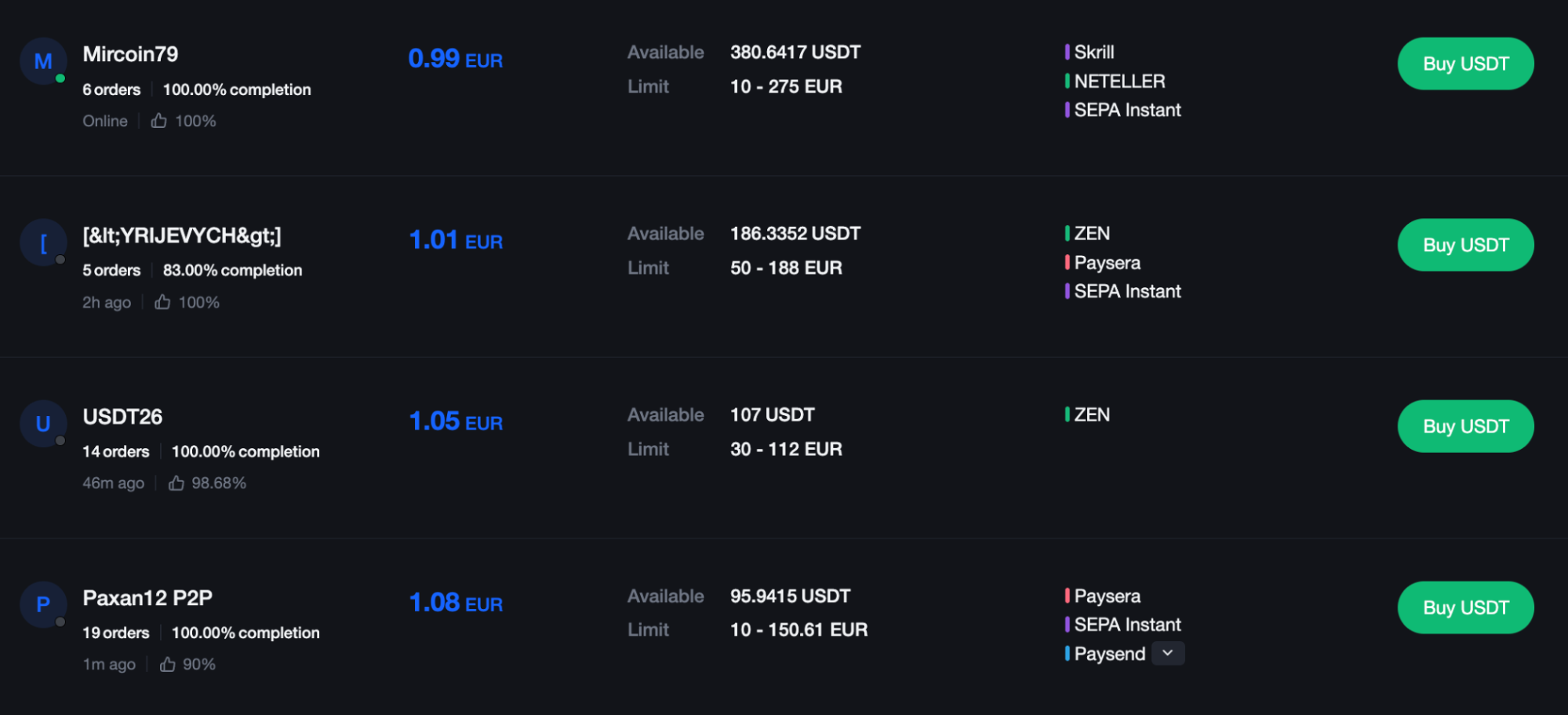
Standard exchanges use the order book system, which means prices are determined by market forces. Market makers ensure prices align with global spot rates.
KYC Requirements
Traditional centralized exchanges have increased their focus on KYC enforcement since the U.S. fined Binance $4 billion for money laundering failures. The result is that major exchanges require users to upload a government-issued ID when they buy cryptocurrencies with fiat money.
Peer-to-peer exchanges bypass these requirements, as buyers and sellers conduct trades directly. Platforms merely provide escrow services, meaning they don’t directly hold client funds. This makes the P2P system ideal for those who favor privacy and anonymity.
Supported Markets
Popular exchanges like MEXC and Bybit support thousands of cryptocurrencies across spot and futures markets. Yet, the same exchanges list just four crypto assets on their respective P2P platforms.
BingX users face similar challenges – P2P buyers can only purchase USDT while the main exchange supports over 1,000 coins.
The P2P framework helps investors enter the broader crypto ecosystem with fiat money, which is why it supports so few markets.
Payments and Currencies
When using a P2P Bitcoin exchange, you have access to a significant range of payment methods and currencies.
Users based in countries with limited exchange support can easily buy digital assets with local bank transfers, mobile payments, and domestic e-wallets. Transactions settle in the national currency, so buyers avoid foreign exchange fees.
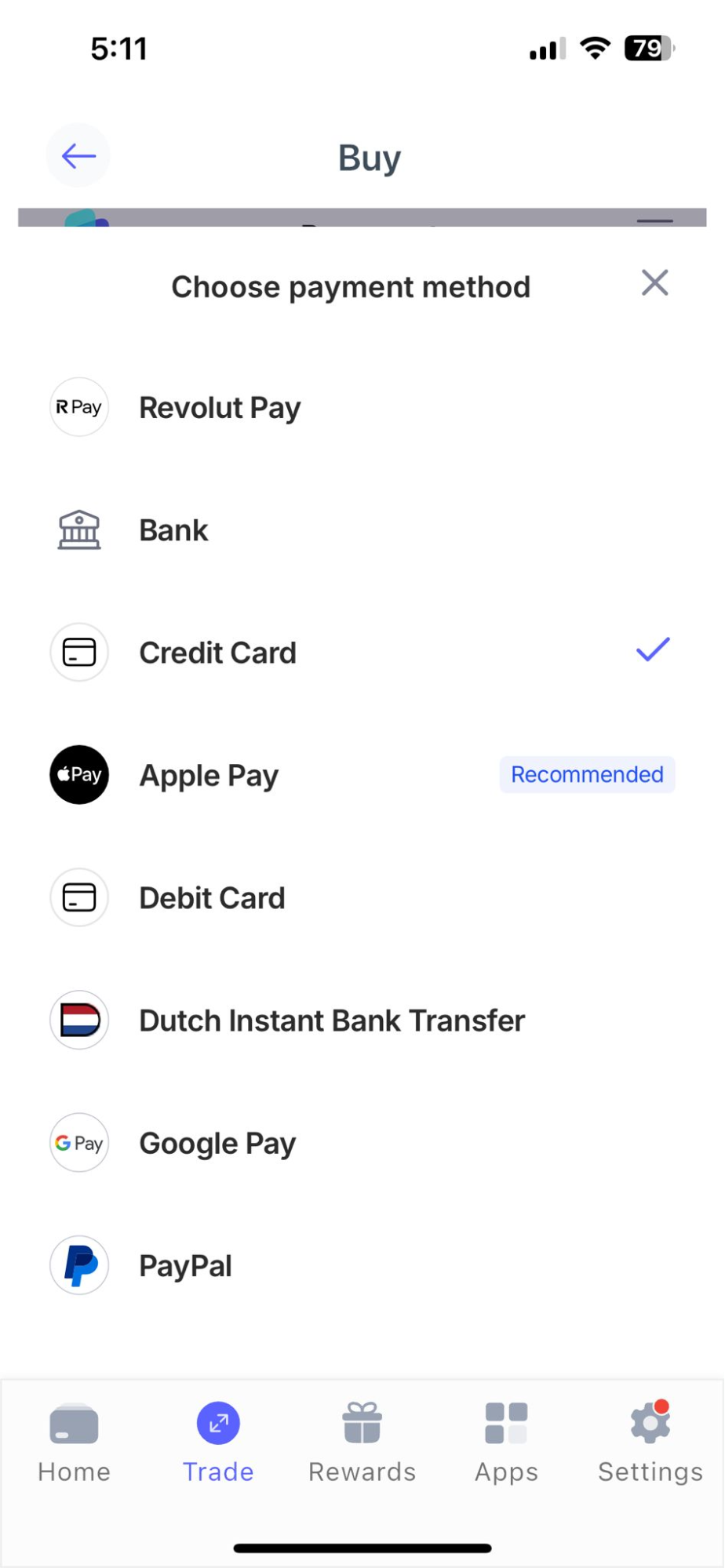
Major exchanges, which support a global audience, typically offer fiat services in major currencies like USD, GBP, and EUR, and payments are limited to debit/credit cards. This lack of support for non-major payments alienates users outside of the developed world.
Liquidity
While peer-to-peer cryptocurrency exchanges rarely publish daily volumes, our research indicates that they account for a fraction of traditional spot trading markets.
For instance, platforms like MEXC, Binance, and OKX handle billions of dollars in transactions every day, yet the top P2P traders average volumes of only several thousand dollars. This directly impacts liquidity levels, whereas significant investments require multiple P2P sellers to meet the full requirement.
Peer-to-Peer Crypto Exchanges vs OTC Exchanges
Peer-to-peer crypto exchanges connect buyers and sellers, so both parties avoid centralized exchanges or intermediaries. Sellers choose their exchange rates, and buyers are free to purchase assets from their preferred merchant. P2P providers support a wide range of currencies and local payment types, making it more convenient to send and receive money.
The peer-to-peer concept is generally a good fit for casual users with small trading requirements, as liquidity levels are limited. It’s also popular with traders who favor anonymity, as many P2P platforms offer anonymous accounts.
OTC exchanges serve large-scale traders – typically those investing six or seven figures. The process requires a centralized broker to complete due diligence on the individual, including their purchase requirements and proof of the source of funds. The broker negotiates rates with tier-one liquidity providers, locks in the price, and waits for the buyer to transfer capital.
While OTC traders receive industry-leading prices, the trade-off is substantial account minimums, comprehensive Know Your Customer (KYC) identity verification, and payment methods limited to bank wires.
Is P2P Crypto Trading Secure?
P2P exchanges are generally safe, as the escrow framework ensures secure transactions. After the buyer chooses a merchant and accepts the displayed price, the seller must transfer the digital assets to the escrow wallet, which is controlled by the P2P platform. The platform instructs the buyer when it’s safe to send payment to the seller.
Another safeguard is that some exchanges require sellers to complete a KYC verification process, which deters scammers. Platforms also let buyers leave feedback after completing a trade, so future users can focus on sellers with positive reviews and an established track record.
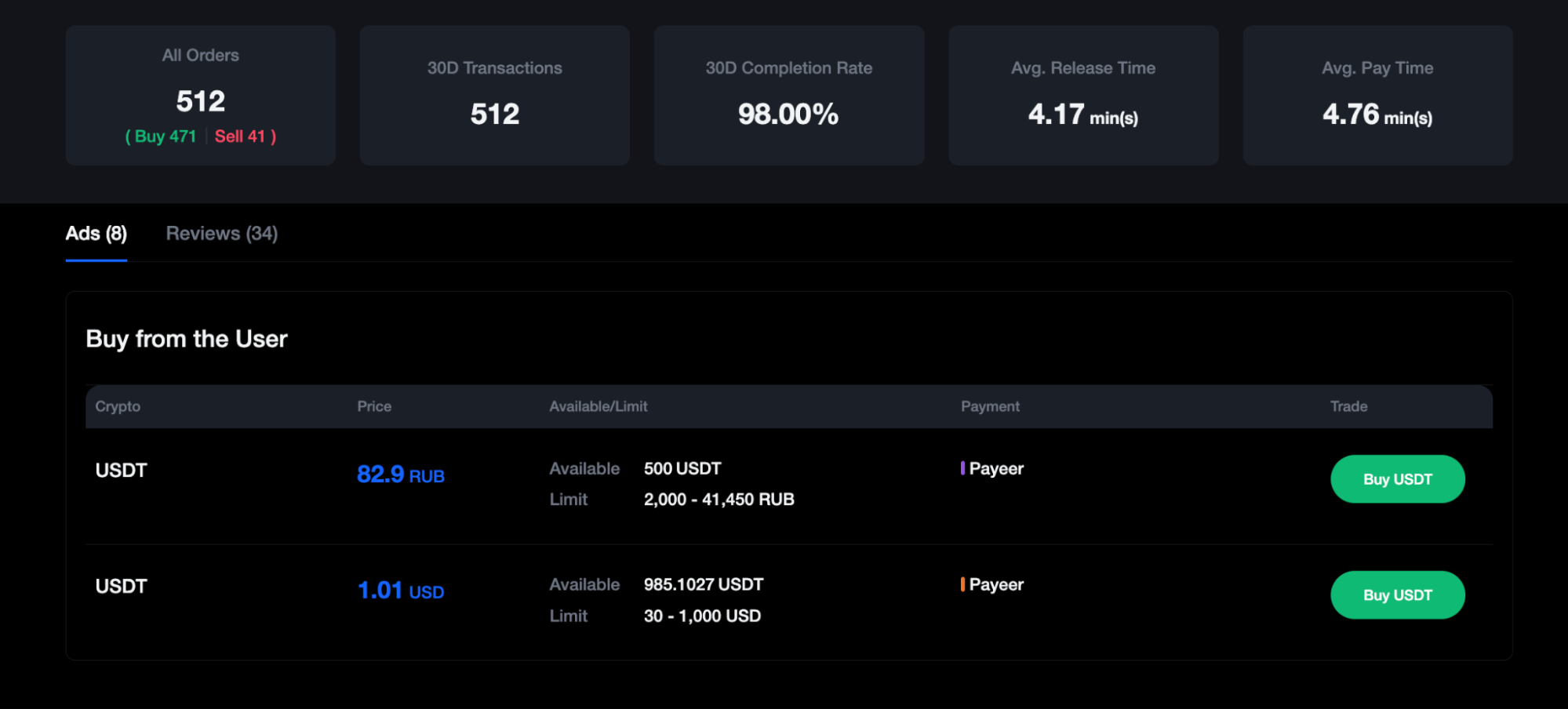
P2P trading isn’t completely risk-free, though. Buyers should report sellers who request to complete trades outside of the platform and ensure they maintain adequate records, such as screenshots of chats and proof of payment. Ensure you use a strong account password and if available, activate two-factor authentication.
How Do I Start P2P Crypto Trading?
Here’s a step-by-step guide on how buy cryptocurrencies safely from peer-to-peer Bitcoin exchanges:
- Step 1: Choose a Platform – The first step is to select a suitable peer-to-peer exchange. Best Wallet is a good choice – it supports over 100 payment methods and more than 1,000 coins, and trades are typically settled within two minutes.
- Step 2: Download the Best Wallet App – Visit the Best Wallet website, download the app, and complete the security steps (e.g, create a PIN and activate biometrics).
- Step 3: Fill the Purchase Form – Click “Trade”, “Buy”, and select the crypto you want to buy. Choose the currency, amount, and purchase method.
- Step 4: Enter the Payment Details – To complete the trade, enter the payment details and confirm. The app processes the payment instantly and transfers the cryptocurrencies to your wallet balance.
Conclusion
Top peer-to-peer cryptocurrency exchanges provide a secure, anonymous, and convenient way to purchase digital assets. You use local currencies and domestic payment methods, and trade directly with sellers in the same country.
Consider Best Wallet when selecting a P2P exchange. Best Wallet offers over 1,000 coins at industry-leading trading fees, and payment types include bank transfers and e-wallets. The Best Wallet app is free, non-custodial, and secure.
References
- Bybit Is Now the World’s Second-Largest Crypto Exchange (Bloomberg)
- Crypto’s Biggest Hacks and Heists After $1.5 Billion Theft From Bybit (Reuters)
- KuCoin Pleads Guilty, Agrees to Pay Nearly $300 Million in US Crypto Case (Reuters)
- Binance and CEO Plead Guilty to Federal Charges in $4B Resolution (U.S. Department of Justice)
Coinspeaker in Numbers
Monthly Users
Articles & Guides
Research Hours
Authors
AlphaPepe has quickly become one of the more talked-about meme presales, thanks to the instant token delivery, active community, a...
In this guide, we explain how to purchase MoonBull tokens through the presale, explore the project's meme-meets-DeFi mechanics.
 17 mins
17 mins
Tony Frank
Crypto Editor, 57 postsTony Frank is an accomplished cryptocurrency analyst, author, and educator whose work bridges the gap between complex blockchain technology and accessible, actionable insights for global audiences. Over the past decade, he has emerged as a respected voice in the rapidly evolving world of digital assets, combining technical expertise with a talent for storytelling to help readers navigate everything from Bitcoin’s monetary philosophy to the intricacies of decentralized finance (DeFi). Tony earned his Bachelor’s degree in Economics and Finance from the University of Melbourne, where he developed a deep interest in monetary systems and market structures. He later pursued a Master’s degree in Blockchain and Digital Currency from the University of Nicosia, one of the first academic institutions to offer accredited programs in cryptocurrency studies. Before focusing full-time on blockchain, Tony worked as a financial analyst for a multinational investment firm, covering emerging technologies and alternative asset classes. His early exposure to macroeconomic policy, global market behavior, and fintech innovation laid the foundation for his later work in crypto research and writing. Tony’s expertise spans multiple sectors of the blockchain industry, including cryptocurrency fundamentals, altcoin market cycles, DeFi and web3 trends and regulatory landscapes. Tony combines on-chain data analysis with macroeconomic research, providing readers with both the technical “how” and the market “why” of cryptocurrency movements.